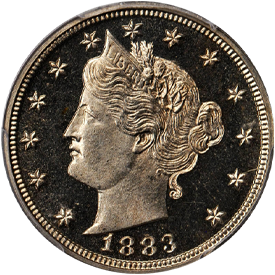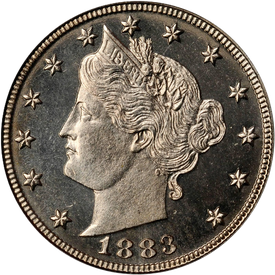Designed by: Charles E. Barber
Issue Date: 1883
Composition: 75% copper, 25% nickel
Diameter: 21.2 mm
Weight: 5.00 grams (77.16 grains)
Edge: Plain
Proof Mintage: 5,219
Proofs were made of all varieties from 1883 through 1912. Mintages were considerably higher than for the Proof silver coinage averaging about 2,800 coins annually. These varied from a low of only 1,475 in 1907 to a high of 6,783 for the 1883 “With Cents” variety. Today, most certified Proofs fall into the PR-63 to PR-66 range with ample quantities available in all these grades. PR-67s are also quite easy to acquire, with a certified population exceeding two thousand pieces. By PR-68, the going gets tougher, but they are by no means terribly challenging, as just over two hundred pieces appear to be extant. That is effectively as high as they get though, as at present, only one PR-69 is known – a cameo example graded by NGC.
Due to the large number of certified examples in the market, prices are not extremely high, with Choice (PR-63-64) examples in the $300-$500 range, Gem (PR-65-66) coin in the $500-$1,000 range and Superb Gem 67’s available in the $1,000-$1,500 range. If you need a PR-68, the jump is wide and prices range from around $4,000 to over $10,000. Of course, cameo contrast will add significantly to the cost, in some cases double or even triple the aforementioned prices.
Two interesting variations among Proofs may be of interest to nickel collectors. The first is a variety of the 1883 without-CENTS on which the “S” of PLURIBUS is sharply doubled. Normally a recut letter does not attract much attention, but in this instance, it is interesting to note that the same reverse die was used to make the transitional pattern 1882 Liberty nickel. The recut letter, which is sharply visible under magnification, serves as an identifying feature. Perhaps one out of three or four 1883 Proof nickels of this type has this recutting.








